I immediately remembered a phrase from a classic work: “To be or not to be, that is the question.” in our case, it can be rephrased a little: “AMD or INTEL? That is the question." In fact, the issue of choosing a processor is very pressing and relevant.
Sooner or later, each of us begins to realize that the power of his E2160 is no longer enough, and for some, the Athlon 64 x2 3800+ also seems very slow. And the owners of such processors, after some time, will go to the store and buy new processors. The owner of an E2160 will buy a brand new Intel, and the owner of an Athlon 64 x2 3800+ will buy an AMD that shines in the sun.
Why did they do this? Why Intel comparison and they didn’t need Amd? Probably because each of these processors has faithfully served its owner for a long time.
But if you already have a processor, for example, AMD Phenom II X4 955-965 Black Edition. Is it worth changing it to Intel Core i3-3220 or Core i5-2500K - 3570K? This question is already quite interesting!
And when such a question is asked on a computer forum, heated debates “Holy War” flare up; they have even been given the corresponding name “Holivar”. In this dispute, some fans argue with others and it is simply impossible to understand who is right and who is wrong. Although no, there is one sure way. If you had an AMD Phenom II X4 955-965 Black Edition or FX 8320, then buy an Intel Core i5-2500K or 3570K and compare what you had and what you received in return. But in this dispute there are no “bad people”; no one is going to sell or buy anything from the “enemy camp”! They will continue to argue like this for another 1000 years... Although, nevertheless, one “bad” one was found, and thank God. I decided to replace the Phenom II X4 955 with a Core i7-2600K - to understand whether Intel processors are as good as everyone writes about them. And understand what advantages and disadvantages each of these processors has.
In this article, dear readers, I will tell you about the strong and weaknesses AMD and INTEL processors, using examples from their real use. And of course, I will provide testing graphs in some benchmarks. Let's probably start with the advantages and disadvantages of AMD and INTEL processors.
Advantages of INTEL processors
- Fast work in applications, if only one is active (games, video converters, photo editors, archivers).
- Lower power consumption.
- Optimized for Intel processor more apps and games.
- Gaming performance is higher than that of similar processors from AMD.
- The latest generations of processors with the “K” index have good overclocking potential.
- Excellent work with RAM.
- Level 2 and 3 memory in the processor operates at a high clock frequency, much faster than AMD processors.
- Multi-threading for Core i7 and Core i3 gives increased performance in optimized applications (archivers, photo editors, video converters).
- Stable operation of the system.
Disadvantages of INTEL processors
- When a new line of processors is released, the platform changes, with the exception of processors with the LGA 1155 socket.
- The ability to simultaneously work with a maximum of two powerful applications (game installation, video converters, photo editors, archivers). That is, we are not talking about multitasking.
- For i7-i5 processors with the “K” index, you need to use more powerful cooling.
- High cost of processors especially Core i3 – i5 – i7.
Advantages of AMD processors
- Affordable price.
- Good cost/performance ratio.
- Multiplatform - i.e. if you currently have a computer built on the AM2+ socket and installed Phenom processor X3 8450, then you can simply buy a processor with an AM3 socket, for example Phenom II X4 955 BE, and install it in the AM2+ socket. Thus, increasing the computer's power by 100% from minimal costs. (The performance difference between the Phenom X3 8450 and the Phenom II X4 955 BE is truly 100-110% depending on the application).
- Multitasking - that is, in systems assembled on the basis of AMD processors, you can simultaneously run 3-4 powerful applications packaging the archive, installing the game, converting videos, unpacking the archive with another archiver and at the same time listening to music and wandering the Internet or just watching a movie. This is tested on Athlon processor II x2 240 and Phenom II X4 955 BE, on a system assembled on the basis of Core i7-2600K and Core i5-2500K - this could not be done at most, installing the game, packaging the archive, listening to music and surfing the Internet and watching a movie.
- Stable system operation.
- You can clearly set the voltage on the processor core, even on the cheapest motherboard.
- Good overclocking potential of FX processors.
- All AMD processors can be overclocked by 10-20%.
Disadvantages of AMD processors
- AMD processors “live in an aggressive environment all the time” because shell A large number of applications, programs and games are written for Intel.
- Energy consumption is higher than that of INTEL processors.
- For FX and Phenom II X4-X6 series processors, you need to purchase a good processor cooler, because... The regular one copes poorly with its functions.
- Working with RAM is a little worse than Intel's.
- Level 2 and 3 cache memory operates at a lower frequency than that of Intel processors.
In principle, these are all the advantages and disadvantages that were identified by me during the operation of AMD and INTEL processors. Further testing of processors.
Test results for AMD and INTEL processors using the example of Phenom II X4 955 BE, Core i7-2600K, Core i5-2500K.
When passing the tests, all processors operated at a frequency of 3.4 GHz with the same RAM operating at a frequency of 1600 MHz and timings of 11-11-11-28.
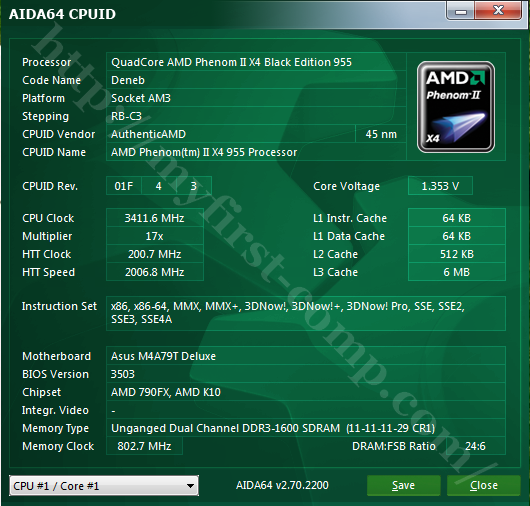


AIDA 64 test results for AMD Phenom II x4 955 BE processor cache and random access memory systems

AIDA 64 test results for cache memory of Intel Core i5-2500K processorand system RAM
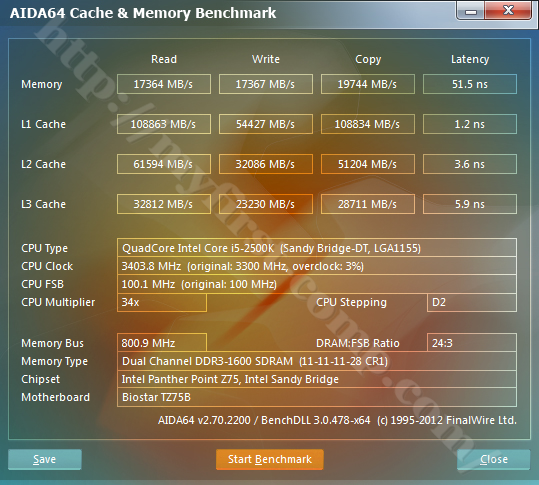
AIDA 64 test results for Intel Core i7-2600K processor cache memoryand system RAM
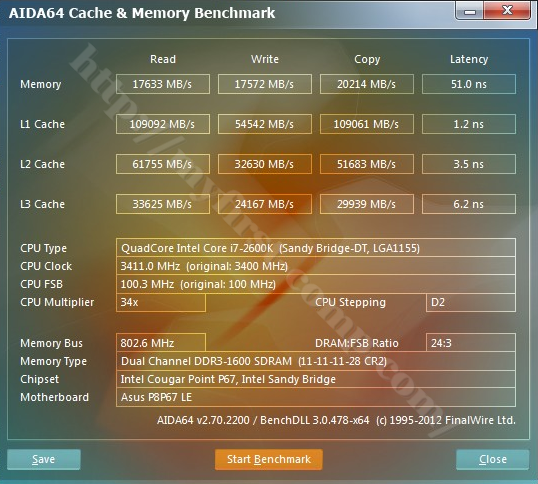
Testing No. 1 in AIDA 64 AMD Phenom II x4 955 BE, Intel Core i5-2500K, Core i7-2600K
 Testing No. 2 in AIDA 64 AMD
Testing No. 2 in AIDA 64 AMD 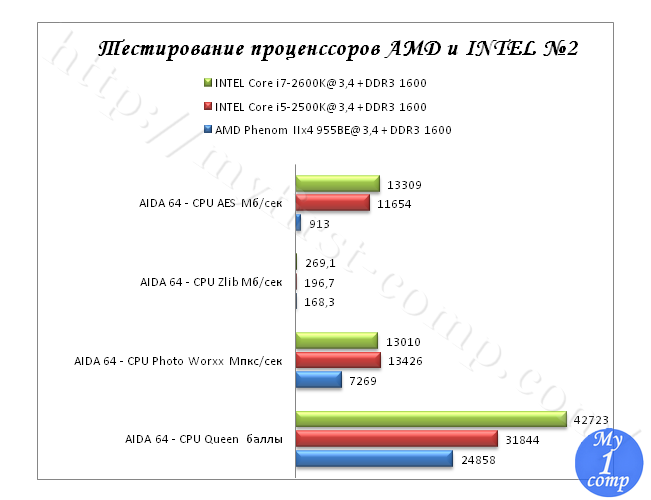 Testing No. 3 in AIDA 64 AMD Phenom II x4 955 BE, Intel Core i5-2500K, Core i7-2600K
Testing No. 3 in AIDA 64 AMD Phenom II x4 955 BE, Intel Core i5-2500K, Core i7-2600K  In the PCMark07 benchmark - processor AMD Phenom II x4 955 BE scored 2432 points
In the PCMark07 benchmark - processor AMD Phenom II x4 955 BE scored 2432 points 
In the PCMark07 benchmark -
Intel Core i5-2500K processorscored 2927 points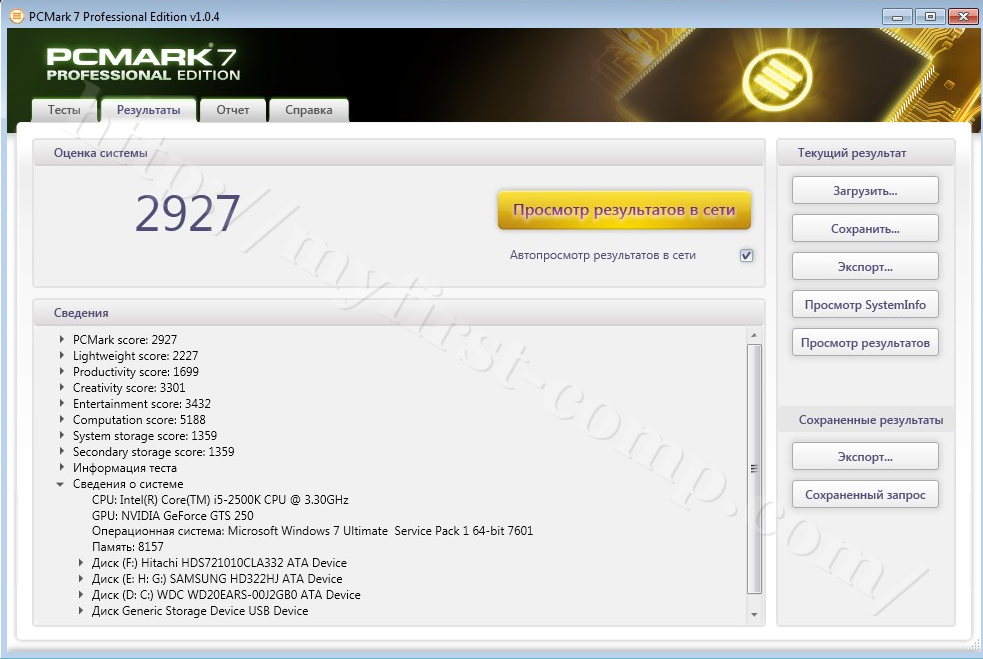
In the PCMark07 benchmark -Intel Core i7-2600K processorscored 3156 points
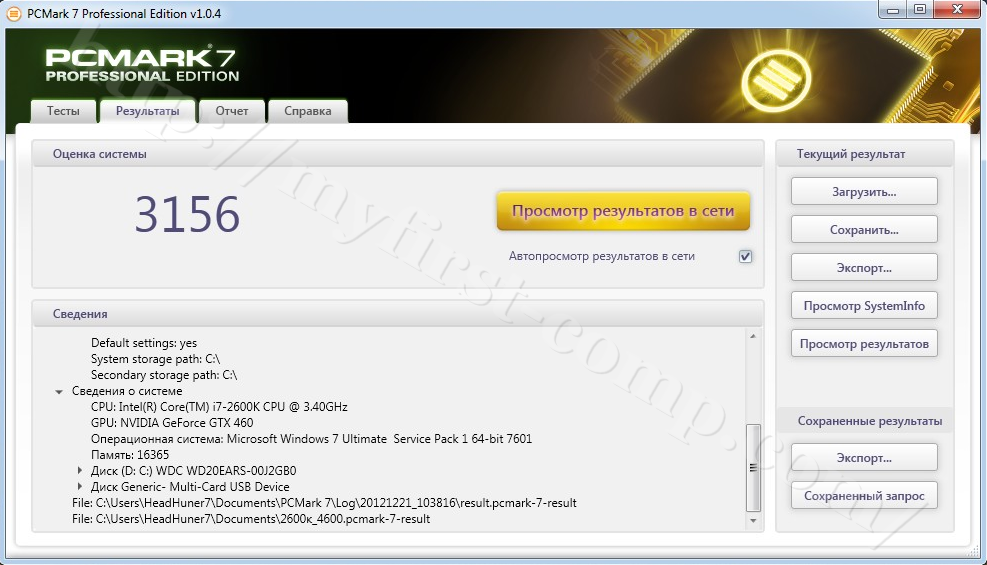
The AMD Phenom II x4 955 BE processor was rated at 3723 points, and 4-core at 13096 points 
In the CINEBENCH R10 benchmark, single-core performance
Intel Core i5-2500K processorwas rated at 5524 points, and 4-cores at 19484 points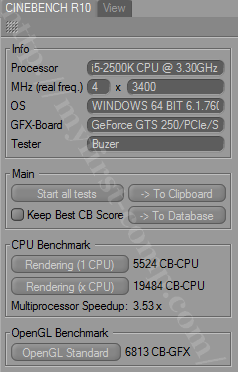
In the CINEBENCH R10 benchmark, single-core performance
Intel Core i7-2600K processorwas rated at 6097 points, and 4-cores at 23341 points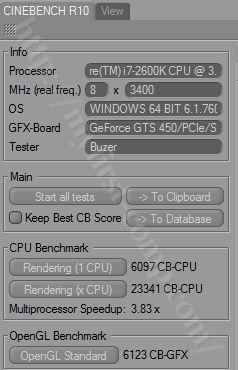
Processor performance rating in 3DMark06:
- AMD Phenom II X4 955 BE: 4310 points
- Intel Core i5-2500K: 5821 points
- Intel Core i7-2600K: 6729 points
Processor performance rating in 3DMark Vantage:
- AMD Phenom II X4 955 BE: 10764 points
- Intel Core i5-2500K: 17310 points
- Intel Core i7-2600K: 22709 points
In synthetic tests, Intel processors are kings - that's a fact. After all, all tests are sensitive to the processor memory frequency. But in real applications, games, video converters and everyday tasks there is no such crazy advantage, and if you compare the cost of one and another processor, then you should think even more seriously.
As a user, I would like to say that both Intel and Amd make wonderful processors. It’s just that Intel’s marketers have been working amazingly since the first day, the release of the very first Intel processor. And AMD is forced to take the market with a lower price for its processors. This is a small lyrical digression from the topic.
AMD or INTEL office computer?
Here I will try to answer the following question: “To build an office computer, which processor is better to use AMD or INTEL? " There really isn't much difference! Why does your soul lie more on that and collect office computer. Both companies have excellent budget processors. Intel Celeron G465, G540, G550. Amd Sempron 140, 145, A4-3300, A4-3400 or Athlon II X2.
Each of these processors has enough power to work in an office, school, university or any other institution that needs an economical and moderately powerful processor.
Multimedia computer INTEL or AMD?
Let's decipher this question as follows: “To build a multimedia computer, which processor is better to use INTEL or AMD?” This question is quite interesting. If you want to build a multimedia computer without a discrete video card, on which you can comfortably play games from 2008-2010, then it is better to pay attention to the Trinity APU from AMD - this is a good processor part plus an average-performance video card, as well as the possibility of creating a compact, a quiet and at the same time quite productive multimedia computer. If it is a computer with a discrete video card of the class: GT 640, GT 630, HD 6670, HD 7750, HD 6570. Then the series processors are perfect for you: Athlon II x4 640, 740K,750K, Intel Pentium G2020,G860,G2120 and others. In this case, it all depends on the person’s preferences and the tasks that this multimedia PC will solve. Regardless of the processor you choose, AMD or INTEL, you will be satisfied.
AMD or INTEL gaming computer?
Probably the most pressing question is which AMD or INTEL processor to build a gaming computer on. In this case, opinions are divided. I will say for myself that it all depends on the video camera you have chosen. For Radeon HD 7850, HD 6950, GTX 560, GTX 560 Ti, GTX 570, GTX 660, an AMD Phenom II X4 955 BE or FX6300 processor overclocked to 3.8 GHz or a Core i3 3220 is sufficient. For a GTX 660 Ti or HD 7950 – the power of the FX 8320 or FX 8350 is quite enough. But if there are 2-3 video cards in the system. or if you plan to use very powerful video cards of the GTX 670, GTX 680, GTX 590, GTX 690, HD7970, HD7990, GTX Titan class - then it is better to pay attention to Intel Core i5 -2500K, 3570K, Core i7-2600K, 2700K, 3770K processors – they may need to be dispersed a little. So for gaming computers Average and slightly above average level, the optimal solution would be to purchase an AMD or Intel Core i3 processor for powerful gaming computers the best solution there will be an assembly based on Intel processors Core i5 –i7 with index “K”.
I’ll be honest, if someone asks me: “Which is better to buy a Phenom II X4 955 BE or a Core i3 3220?” I’ll answer “definitely the 955” and I’m not even afraid of its power consumption and heating. Since the Phenom II X4 955 and cooling Cooler Master Hyper 212 Plus Evo are cheaper than the boxed version of the Core i3 3220. And if they ask what is better Phenom II X4 955 or Core i5-2500K, Core i5-3450, then I will answer “Which Core i5 better, but more expensive."
So which processor is better AMD or INTEL?
I hope reading this article will help you decide on the choice of processor between AMD and INTEL. It took me a long time to compare what I had and what I have now. I didn’t see a huge performance increase when I switched to Intel, although there are still some advantages.
Both companies produce wonderful processors and it’s good that there are two of them. Both companies also have problems, but all of them are resolved and taken into account when releasing new series of processors and core stepping of old ones. The great popularity of Intel processors, in my opinion, is, firstly, due to the fact that the company appeared on the processor market earlier, and secondly, professional marketing and various partnership programs Intel is doing their job. Intel is on everyone's lips and every dog knows Intel has something to do with computers and if you build a PC, it must be on Intel. Another argument in favor of AMD is that guys working in stores selling computer components assemble computers based on AMD processors. And when you come to their store, they will definitely sell you Intel =) . This is how bad luck turns out.
So it’s up to you to decide which AMD or INTEL processor you will have in your computer or laptop! I cited all the pros and cons in this article, I didn’t invent anything, I wrote everything as it is, without exaggeration or deliberate understatement by one of the parties. Test results are also available. So now you will definitely do it right choice processor!
Best processor for gaming | Benefit reduction effect
Processor prices top level are growing rapidly, but the performance gain in games will be less and less. Therefore, it is hardly worth recommending a processor more expensive than the Core i5-7600K. Moreover, if there is good cooler this model can be overclocked to 5 GHz - if more is required high performance.
However, there are a small number of games that reveal the possibilities Core processors i7 with Hyper-Threading technology. We believe the trend of multi-core gaming optimization will continue, which is why we've added the Core i7-5820K to the list. For most games, there won't be much difference between a Core i7 and a Core i5, but if you're the kind of enthusiast who wants future-proofing and strong performance in multi-threaded applications, this CPU may be worth the extra cost.
With the advent of the LGA 2011-v3 interface, there is every reason to build an unsurpassed gaming platform on its basis. Haswell-E-based processors have more available cache and four more cores compared to leading LGA 1150/1155 socket models. In addition, thanks to the four-channel controller, greater throughput memory. With 40 Gen 3 PCIe lanes available on processors Sandy Bridge-E, the platform natively supports two x16 slots and one x8 slot, or one x16 slot and three x8 slots, removing potential bottlenecks in CrossFire or SLI configurations for three and four video cards.
While all of the above sounds impressive, it doesn't necessarily translate into significant performance improvements in modern games. Our tests show very little difference between the $240 LGA 1150 Core i5-4690K and the $1000 LGA 2011 Core i7-4960X, even with three SLI graphics cards installed. It turns out that memory bandwidth and PCIe do not greatly affect the performance of current Sandy Bridge architecture systems.
Where Haswell-E really shines is in CPU-intensive games like Battlefield 1's multiplayer. If you're running three or four graphics cards, chances are you already have enough performance. An overclocked Core i7-5960X or Core i7-5930K can help the rest of the platform catch up to the extremely powerful video system.
In general, although we do not recommend buying a processor more expensive Core i5-7600K in terms of price/performance ratio (the amount of money saved can be spent on a graphics adapter and system board), there will always be those who will spare no expense in the pursuit of achieving the highest possible performance.
Best processor for gaming | comparison table
What about other processors that aren't on our list of recommendations? Are they worth buying or not?
Such questions are quite appropriate, since accessibility different models and their prices change daily. How do you know if the processor you've got your eye on is the best buy in its price range?
We decided to help you in this difficult task by presenting a CPU hierarchy table, where processors of the same gaming performance level are on the same line. The top lines show the most powerful gaming CPUs, and as you move down the lines, performance decreases.
Proposed hierarchical table various models processors Intel and AMD were initially based on the average performance of each in our benchmark suite. We later added new game data as part of the evaluation criteria, but keep in mind that different games behave differently due to their unique characteristics. program code. For example, some of them are extremely dependent on graphics power, but others respond positively to more cores, cache memory, or even a specific architecture.
We don't have the ability to test every CPU on the market, so in some cases rankings will depend on the results of similar models. Essentially, this hierarchical table is useful as a general selection guide, but it is not a universal means of comparing different processors. For more detailed information, please refer to (English) or to the regularly updated section " Best CPU for Gaming: Current Market Analysis ".
You may have noticed that we have divided the flagship section into two levels processors and on one of them they placed several quad-core AMD models. Given that many older platforms can be used with several different generations of graphics subsystems, we wanted to highlight the highest-performance models to maintain a balance between the system and the video accelerator. For example, on this moment, any Core i7 owner Generation Sandy Bridge will see a significant boost when moving to Kaby Lake or Broadwell-E. And the flagship premises processors AMD series FX being one step up from several Core i7s and older Core i5s means their status is upgrading.
Hierarchy of Intel and AMD processors | Table
| Intel | AMD |
| Core i7-3770, -3770K, -3820, -3930K, -3960X, -3970X, -4770, -4771, -4790, -4770K, -4790K, -4820K, -4930K, -4960X, -5775C, -5820K, 5930K, -5960X, -6700K, -6700, -7700K, -7700, -6800K, -6850K, -6900K, -6950X Core i5-7600K, -7600, -7500, -7400, -6600K, -6600, -6500, -5675C, -4690K, 4670K, -4590, -4670, -4570, -4460, -4440, -4430, -3570K, -3570, -3550 |
|
| Core i7-2600, -2600K, -2700K, -965, -975 Extreme, -980X Extreme, -990X Extreme Core i5-3470, -3450P, -3450, -3350P, -3330, 2550K, -2500K, -2500, -2450P, -2400, -2380P, -2320, -2310, -2300 |
FX-9590, 9370, 8370, 8350, 8320, 8300, 8150 |
| Core i7-980, -970, -960 Core i7-870, -875K Core i3-7350K, -7320, -7300, -7100, -4360, -4350, -4340, -4170, -4160, -4150, -4130, -3250, -3245, -3240, -3225, -3220, -3210 , -2100, -2105, -2120, -2125, -2130 Pentium G4620, G4600, G4560 |
FX-6350, 4350 Phenom II X6 1100T BE, 1090T BE Phenom II X4 Black Edition 980, 975 |
| Core i7-860, -920, -930, -940, -950 Core i5-3220T, -750, -760, -2405S, -2400S Core 2 Extreme QX9775, QX9770, QX9650 Core 2 Quad Q9650 |
FX-8120, 8320e, 8370e, 6200, 6300, 4170, 4300 Phenom II X6 1075T Phenom II X4 Black Edition 970, 965, 955 A10-6800K, 6790K, 6700, 5800K, -5700, -7700K, -7800, -7850K, 7870K A8-3850, -3870K, -5600K, 6600K, -7600, -7650K Athlon X4 651K, 645, 641, 640, 740, 750K, 860K |
| Core 2 Extreme QX6850, QX6800 Core 2 Quad Q9550, Q9450, Q9400 Core i5-650, -655K, -660, -661, -670, -680 Core i3-2100T, -2120T |
FX-6100, -4100, -4130 Phenom II X6 1055T, 1045T Phenom II X4 945, 940, 920 Phenom II X3 Black Edition 720, 740 A8-5500, 6500 A6-3650, -3670K, -7400K Athlon II X4 635, 630 |
| Core 2 Extreme QX6700 Core 2 Quad Q6700, Q9300, Q8400, Q6600, Q8300 Core 2 Duo E8600, E8500, E8400, E7600 Core i3 -530, -540, -550 Pentium G3470, G3460, G3450, G3440, G3430, G3420, G3260, G3258, G3250, G3220, G3420, G3430, G2130, G2120, G2020, G2010, G870, G860, G850, G840, G645, G 640, G630 |
Phenom II X4 910, 910e, 810 Athlon II X 4 620, 631 Athlon II X3 460 |
| Core 2 Extreme X6800 Core 2 Quad Q8200 Core 2 Duo E8300, E8200, E8190, E7500, E7400, E6850, E6750 Pentium G620 Celeron G1630, G1620, G1610, G555, G550, G540, G530 |
Phenom II X4 905e, 805 Phenom II X3 710, 705e Phenom II X2 565 BE, 560 BE, 555 BE, 550 BE, 545 Phenom X4 9950 Athlon II X 3 455, 450, 445, 440, 435, 425 |
| Core 2 Duo E7200, E6550, E7300, E6540, E6700 Pentium Dual-Core E5700, E5800, E6300, E6500, E6600, E6700 Pentium G9650 |
Phenom X4 9850, 9750, 9650, 9600 Phenom X3 8850, 8750 Athlon II X2 265, 260, 255, 370K A6-5500K A4-7300, 6400K, 6300, 5400K, 5300, 4400, 4000, 3400, 3300 Athlon 64 X2 6400+ |
| Core 2 Duo E4700, E4600, E6600, E4500, E6420 Pentium Dual-Core E5400, E5300, E5200, G620T |
Phenom X4 9500, 9550, 9450e, 9350e Phenom X3 8650, 8600, 8550, 8450e, 8450, 8400, 8250e Athlon II X2 240, 245, 250 Athlon X2 7850, 7750 Athlon 64 X2 6000+, 5600+ |
| Core 2 Duo E4400, E4300, E6400, E6320 Celeron E3300 |
Phenom X4 9150e, 9100e Athlon X2 7550, 7450, 5050e, 4850e/b Athlon 64 X2 5400+, 5200+, 5000+, 4800+ |
| Core 2 Duo E5500, E6300 Pentium Dual-Core E2220, E2200, E2210 Celeron E3200 |
Athlon X2 6550, 6500, 4450e/b, Athlon X2 4600+, 4400+, 4200+, BE-2400 |
| Pentium Dual-Core E2180 Celeron E1600, G440 |
Athlon 64X 2 4000+, 3800+ Athlon X2 4050e, BE-2300 |
| Pentium Dual-Core E2160, E2140 Celeron E1500, E1400, E1200 |
Currently our table consists of 13 levels. The bottom half of the list is mostly no longer relevant: these chips will demonstrate insufficient performance in modern games, regardless of installed video card. If your CPU belongs to this half of the list, then the upgrade will really increase your enjoyment of the games.
Last update: 12/01/2016 (added the following SoCs: Qualcomm Snapdragon 625 MSM8953, Qualcomm Snapdragon 430 MSM8937, Mediatek MT6732)
ARM processor is a mobile processor for smartphones and tablets.
This table shows all currently known ARM processors. The table of ARM processors will be supplemented and upgraded as new models appear. This table uses a conditional system for evaluating CPU and GPU performance. ARM processor performance data was taken from a variety of sources, mainly based on the results of tests such as: PassMark, Antutu, GFXBench.
We do not claim absolute accuracy. Absolutely accurately rank and evaluate the performance of ARM processors impossible, for the simple reason that each of them has advantages in some ways, but in some ways lags behind other ARM processors. The table of ARM processors allows you to see, evaluate and, most importantly, compare different SoCs (System-On-Chip) solutions. Using our table, you can compare mobile processors and it’s enough to find out exactly how the ARM heart of your future (or present) smartphone or tablet is positioned.
Here we have compared ARM processors. We looked at and compared the performance of CPU and GPU in different SoCs (System-on-Chip). But the reader may have several questions: Where are ARM processors used? What is an ARM processor? How does ARM architecture differ from x86 processors? Let's try to understand all this without going too deep into details.
First, let's define the terminology. ARM is the name of the architecture and at the same time the name of the company leading its development. The abbreviation ARM stands for (Advanced RISC Machine or Acorn RISC Machine), which can be translated as: advanced RISC machine. ARM architecture combines a family of both 32 and 64-bit microprocessor cores developed and licensed by ARM Limited. I would like to note right away that the ARM Limited company is exclusively engaged in the development of kernels and tools for them (debugging tools, compilers, etc.), but not in the production of the processors themselves. Company ARM Limited sells licenses for the production of ARM processors to third parties. Here is a partial list of companies licensed to produce ARM processors today: AMD, Atmel, Altera, Cirrus Logic, Intel, Marvell, NXP, Samsung, LG, MediaTek, Qualcomm, Sony Ericsson, Texas Instruments, nVidia, Freescale... and many others.
Some companies that have received a license to produce ARM processors create their own versions of cores based on ARM architecture. Examples include: DEC StrongARM, Freescale i.MX, Intel XScale, NVIDIA Tegra, ST-Ericsson Nomadik, Qualcomm Snapdragon, Texas Instruments OMAP, Samsung Hummingbird, LG H13, Apple A4/A5/A6 and HiSilicon K3.
Today they work on ARM-based processors virtually any electronics: PDA, Cell phones and smartphones, digital players, portable game consoles, calculators, external hard disks and routers. They all contain an ARM core, so we can say that ARM - mobile processors for smartphones and tablets.
ARM processor represents a SoC, or "system on a chip". An SoC system, or “system on a chip,” can contain in one chip, in addition to the CPU itself, the remaining parts of a full-fledged computer. This includes a memory controller, an I/O port controller, a graphics core, and a geopositioning system (GPS). It may also contain a 3G module, as well as much more.
If we consider a separate family of ARM processors, say Cortex-A9 (or any other), it cannot be said that all processors of the same family have the same performance or are all equipped with a GPS module. All these parameters strongly depend on the chip manufacturer and what and how he decided to implement in his product.
What is the difference between ARM and X86 processors?? The RISC (Reduced Instruction Set Computer) architecture itself implies a reduced set of instructions. Which accordingly leads to very moderate energy consumption. After all, inside any ARM chip there are much fewer transistors than its counterpart from the x86 line. Don't forget that in an SoC system all peripheral devices are located inside a single chip, which allows the ARM processor to be even more energy efficient. The ARM architecture was originally designed to calculate only integer operations, unlike x86, which can work with floating point calculations or FPU. It is impossible to clearly compare these two architectures. In some ways, ARM will have an advantage. And somewhere it’s the other way around. If you try to answer the question in one phrase: what is the difference between ARM and X86 processors, then the answer will be this: the ARM processor does not know the number of commands that the x86 processor knows. And those that do know look much shorter. This has both its pros and cons. Be that as it may, in Lately everything suggests that ARM processors are slowly but surely starting to catch up, and in some ways even surpass conventional x86 processors. Many openly declare that ARM processors will soon replace the x86 platform in the home PC segment. As we already know, in 2013 several world-famous companies completely abandoned the further production of netbooks in favor of tablet PCs. Well, what will actually happen, time will tell.
We will monitor the ARM processors already available on the market.
When buying a new computer, the same question always arises - how to compare processors, how to understand which one is better. It is known that processor power greatly affects the performance of the system as a whole. But what does the performance of the processor itself depend on?
Let's figure it out.
Is clock speed that important?
Processor clock speed is measured in hertz—usually gigahertz (GHz). The clock speed of a CPU is a measure of how many cycles per second it can perform. For example, a 1.8 GHz processor can perform 1,800,000,000 clock cycles per second. A clock cycle can be called the time during which the CPU performs a microoperation. For example, an operation to read data from RAM may consist of several micro-operations.
At first glance, it seems logical that the more clock cycles per second it can perform, the more productive it is. Yes and no.
For a reliable comparison criterion, clock frequencies can be used when considering similar processors from the same series. Let's say you are comparing two processors, the Intel Core i5-4460 and the Intel Core i5-4670K, which differ only in their clock speeds. The first operates at a frequency of 3.2 GHz, and the second at a frequency of 3.4 GHz. In this case, the 3.4 GHz processor will be 30% faster when they are both running at their maximum speed. But you cannot compare the frequency of a processor from the Haswell Core i5 family with AMD processor, ARM or even with i7.
Modern processors are becoming much more efficient. They can get more things done in a cycle. For example, the Intel Pentium 4 with a clock speed of 3.6 GHz was released in 2006, and the i7 Intel Haswell run at 3.9 GHz. Does this mean that processor performance has only improved slightly in the last 10 years? Of course not.
Cache
The processor cache is a form of memory allocated to the processor, which works in a similar way to RAM.
The cache is built directly into the processor die. From there, the process accesses reusable data directly from its own memory, rather than repeatedly requesting it from system memory, which significantly saves time.
Cache memory comes in different levels, L1, L2, L3 and even more in new processors. L1 represents a small amount of very fast memory, and each subsequent level is larger and slower. The processor uses each level according to the importance of the data, the most important data will be stored in the L1 cache.
Haswell processors have 64 KB L1 cache, L2 - L3 cache, 256 KB up to 20 MB and L4 up to 128 MB cache.
It's hard to say how much cache memory you need, but 3-6MB is typical in modern laptops and desktop computers. More cache means better performance.
Set of instructions
It is the “firmware” of the processor itself that tells you how to perform actions. You have no control over the command set. It is built into the processor and cannot be changed or upgraded. But together with the processor architecture, this affects the performance of processors. determines how many cycles are required to execute a given instruction.
In other words, some instruction sets are more efficient than others, allowing the processor to do more useful work at a given speed. But you shouldn’t go into such a jungle and take this parameter into account when buying a computer for your home.
A few words about the number of cores
Each processor "core" is actually a separate processing unit. Additional cores allow the computer to do several things at the same time. You will remember that I had a single-core processor, but it also did a lot of things at the same time - the browser worked, music played and coursework was done.
In fact, this is just an illusion of simultaneity; in fact, the processor switches between tasks every time, performing part of the work from each process, it does it so quickly that we do not notice. 
The more processors or cores a computer has, the more things it can do at once. Let's imagine that we have 100 tasks and 4 engineers (cores), each doing 25 tasks, and of course, all 100 will be done faster than one. But there are such complex large-scale tasks that cannot be divided, and it looks like one engineer is working, and three are resting. What follows from this is that not all software works more efficiently on multi-core processors than on one.
Total - the more cores, the better
In which parrots is performance measured?
MIPS (million operations per second) and FLOPS units are often used.
MIPS as well as clock frequency It makes no sense to use it for processors of different architectures. Sometimes it is also called Meaningless Indicator of Processor Speed. Since the number of operations cannot serve as an indicator of “useful” productivity. Exaggeratedly, one processor will multiply two numbers in one operation, and another by 10, but the operation of the second processor takes half as much time. Obviously, the first one will be faster.
A more universal measure of FLOPS is the number of floating point operations per second. Floating point is the most useful representation of numbers in processors. By measuring FLOPS, all processors are forced to do the same thing. Of course, this test is more universal and suitable for measuring performance.
CPU performance value
Few would argue that the overall performance of a computer largely depends on the processor. But it would be a mistake to think that it completely defines it. It is possible to choose a configuration where the entire potential of the processor can be ruined
What affects performance:
- Motherboard internal bus frequency
- Frequency
- Hard drive rotation speed

Benchmarks
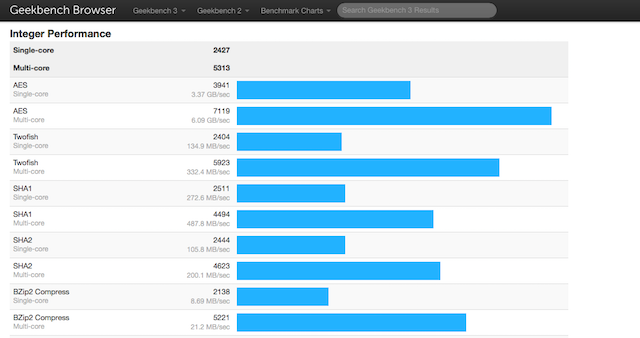
What is a benchmark?
A benchmark involves a series of software tests that replicate the types of tasks performed in actual computer use. For example, the CPU in a laptop will be tested to see how quickly it can compress or encrypt data. HDD will be checked for read record speed, etc.
How important are benchmark indicators?
The benchmark results are used for comparative analysis. They are particularly good at showing how performance improves from one generation to the next and can help you evaluate a product's value for money.
They are best used when you have specific requirements, be it gaming, video editing, or anything else resource-intensive.
But for solving everyday computing problems - web surfing, social. networking and text editing - the performance difference is barely noticeable. Because the benchmark shows peak performance values.
What benchmarks exist
- Test with floating point operations. Results are often displayed in milliseconds, so lower numbers indicate better performance. That is, how quickly one operation will be performed. Based on this time, you can approximately calculate the number of FLOPS.
- Compression tests. Checking the compression speed of large amounts of data. The result looks like a speed of kilobytes per second, so what larger number, all the better.
- Single core tests. Such as CineBench or PassMark, these tests only load one core. Good performance one core is important because there are many software not optimized for multi-core processors.
conclusions
- The clock speed can be used for comparison only among processors from the same series. Comparing different families or architectures is incorrect
- The numerical performance characteristic that is used by FLOPS is the number of floating point operations per second.
- System performance depends not only on processor power, but also on other parameters
- The benchmark results show the difference when maximum load, for tasks that do not fully load the processor, the difference may not be noticeable. Therefore, in order not to overpay, you need to consider for what purpose you are buying.
Almost every year a new generation of central processors enters the market Intel Xeon E5. Each generation alternates the socket and technological process. There are more and more nuclei, and heat generation is gradually decreasing. But a natural question arises: “What does the new architecture give to the end user?”
To do this, I decided to test the performance of similar processors of different generations. I decided to compare models from the mass segment: 8-core processors 2660, 2670, 2640V2, 2650V2, 2630V3 and 2620V4. Testing with such a generational spread is not entirely fair, because Between V2 and V3 there is a different chipset, a new generation of memory with a higher frequency, and most importantly, there are no direct peers in frequency among the models of all 4 generations. But, in any case, this study will help to understand to what extent the performance of new processors has increased in real applications and synthetic tests.
The selected line of processors has many similar parameters: the same number of cores and threads, 20 MB SmartCache, 8 GT/s QPI (except 2640V2) and the number of PCI-E lanes equal to 40.
To assess the feasibility of testing all processors, I turned to the results of the PassMark tests.
Below is a summary graph of the results:
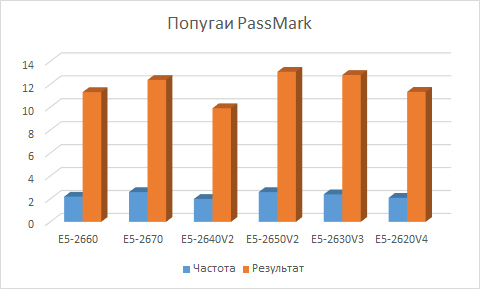
Since the frequency is significantly different, it is not entirely correct to compare the results. But despite this, conclusions immediately arise:
1. 2660 is equivalent in performance to 2620V4
2. 2670 is superior in performance to 2620V4 (obviously due to frequency)
3. 2640V2 sags, and 2650V2 beats everyone (also due to frequency)
I divided the result by frequency and got a certain performance value at 1 GHz:
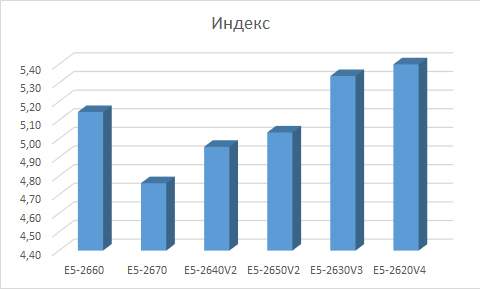
Here the results are more interesting and clear:
1. 2660 and 2670 - an unexpected turnaround for me within one generation, 2670 is justified only by the fact that its overall performance is very high
2. 2640V2 and 2650V2 - a very strange low result, which is worse than the 2660
3. 2630V3 and 2620V4 are the only logical growth (apparently due to new architecture...)
After analyzing the result, I decided to weed out some of the uninteresting models that are of no value for further testing:
1. 2640V2 and 2650V2 - an intermediate generation, and not very successful, in my opinion - I’m removing them from the candidates
2. 2630V3 is an excellent result, but it costs unreasonably more than 2620V4, given the similar performance and, moreover, this is the outgoing generation of processors
3. 2620V4 - reasonable price (compared to 2630V3), high performance and, most importantly, this is the only model of the latest generation 8-core processor with Hyper-threading on our list, so we definitely leave it for further tests
4. 2660 and 2670 - an excellent result in comparison with 2620V4. In my opinion, it is precisely the comparison of the first and last (at the moment) generation in Intel line Xeon E5 is of particular interest. In addition, we still have sufficient stocks of first-generation processors in our warehouse, so this comparison is very relevant for us.
The cost of servers based on 2660 and 2620V4 processors can differ by almost 2 times, not in favor of the latter, so by comparing their performance and choosing a server on V1 processors, you can significantly reduce the budget for purchasing a new server. But I will tell you about this proposal after the test results.
For testing, 3 stands were assembled:
1. 2 x Xeon E5-2660, 8 x 8Gb DDR3 ECC REG 1333, SSD Intel Enterprise 150Gb
2. 2 x Xeon E5-2670, 8 x 8Gb DDR3 ECC REG 1333, SSD Intel Enterprise 150Gb
3. 2 x Xeon E5-2620V4, 8 x 8Gb DDR4 ECC REG 2133, SSD Intel Enterprise 150Gb
PassMark PerformanceTest 9.0
When selecting processors for testing, I already used the results of synthetic tests, but now it’s interesting to compare these models in more detail. I made the comparison in groups: 1st generation versus 4th.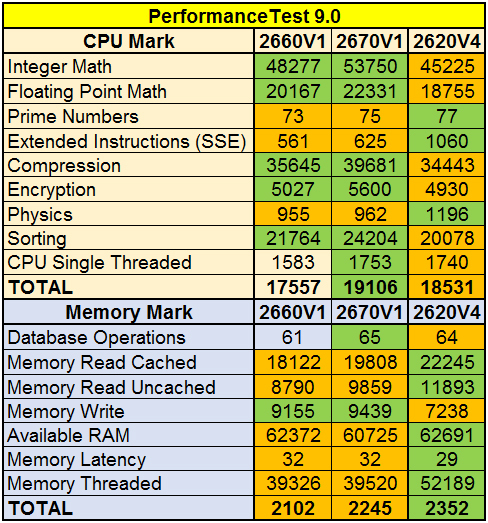
A more detailed testing report allows us to draw some conclusions:
1. Mathematics, incl. and floating point, mainly depends on frequency. The difference of 100 MHz allowed the 2660 to outpace the 2620V4 in computational operations, encryption and compression (and this despite the significant difference in memory frequency)
2. Physics and calculations using extended instructions are performed better on the new architecture, despite the low frequency
3. And, of course, the test using memory passed in favor of V4 processors, since in this case the competition had already different generations memory - DDR4 and DDR3.
It was synthetic. Let's see what specialized benchmarks and real applications show.
Archiver 7ZIP

Here the results have something in common with the previous test - a direct link to the processor frequency. It doesn’t matter that slower memory is installed - V1 processors confidently take the lead in frequency.
CINEBENCH R15
CINEBENCH is a benchmark for evaluating computer performance for working with professional animation software MAXON Cinema 4D.
The Xeon E5-2670 pulled up the frequency and beat the 2620V4. But the E5-2660, which has a not so visible advantage in frequency, lost to the 4th generation processor. Hence the conclusion - this software uses useful additions new architecture (although perhaps it’s all a matter of memory...), but not so much that it would be a decisive factor.
3DS MAX + V-Ray
To evaluate processor performance when rendering in a real application, I took a combination: 3ds Max 2016 + V-ray 3.4 + a real scene with several light sources, specular and transparent materials, and an environment map.
The results were similar to CINEBENCH: the Xeon E5-2670 showed the lowest rendering time, and the 2660 could not beat the 2620V4.
1C: SQL/File
At the end of the testing, I attach the results of the gilev tests for 1C.
When testing a database with file access, the E5-2620V4 processor confidently leads. The table shows the average values of 20 runs of the same test. The difference between the results of each stand in the case of a file database was no more than 2%.
Single thread test SQL databases showed very strange results. The difference turned out to be insignificant, given the different frequencies of the 2660 and 2670, and the different frequencies of DDR3 and DDR4. There was an attempt to optimize the SQL settings, but the results turned out to be worse than they were, so I decided to test all the stands on the basic settings.

The results of the multi-threaded SQL test turned out to be even more strange and contradictory. The maximum speed of 1 thread in MB/s was equivalent to the performance index in the previous single-threaded test.
The next parameter was the maximum speed (of all streams) - the result was almost identical for all stands. Since the results of different runs fluctuated greatly (+-5%) - sometimes they were at different stands with a significant gap in both directions. The same average multi-threaded SQL test results lead me to 3 thoughts:
1. This situation is caused by an unoptimized SQL configuration
2. The SSD became a system bottleneck and did not allow the processors to overclock
3. There is almost no difference between the frequency of memory and processors for these tasks (which is extremely unlikely)
The result for the “Recommended number of users” parameter also turned out to be inexplicable. The average result of 2660 turned out to be the highest - and this despite the low results of all tests.
I will also be glad to see your comments on this issue.
conclusions
The results of several diverse computing tests showed that the processor frequency in most cases turned out to be more important than the generation, architecture, and even memory frequency. Of course, there is modern software that uses all the improvements of the new architecture. For example, video transcoding is sometimes performed incl. using AVX2.0 instructions, but this is specialized software - and most server applications are still tied to the number and frequency of cores.Of course, I’m not saying that there is no difference at all between processors, I just want to point out that for certain applications there is no point in a “planned” transition to a new generation.
If you disagree with me or have suggestions for testing, the stands have not yet been dismantled, and I will be happy to test your tasks.
Economic benefit
As I already wrote at the beginning of the article, we offer a line of servers based on Xeon processors E5 of the first generation, which are significantly cheaper in cost than servers based on E5-2620V4.These are the same new servers (not to be confused with used ones) with a 3-year warranty.
Below is an approximate calculation.




